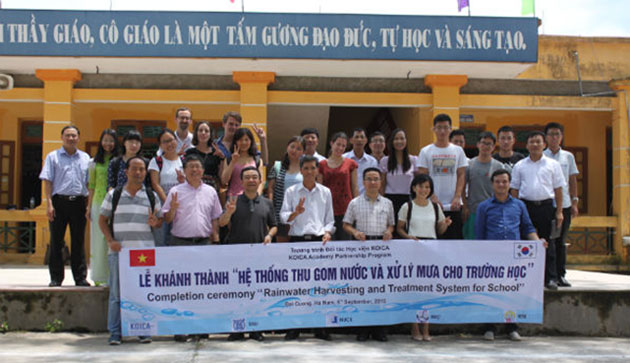
Đại Cường elementary and middle schools of the Hà Nam province of Vietnam
On the 5th of September, Seoul National University’s director of the Rainwater Research Center (Rain for all), Professor HAN Moo-young (Civil and Environmental Engineering) oversaw the completion ceremony of the rainwater upcycling facility in the Đại Cường elementary and middle schools of the Hà Nam province of Vietnam. The project was the result of collaboration between SNU and the Korea International Cooperation Agency (KOICA), a governmental organization which focuses on aiding developing countries.
Professor HAN Moo-young, the director of Rain for all, is in the forefront of rainwater utilization, and is often referred to as Korea’s “Dr. Rain”. Since 2006, he has carried out volunteer work within Korea and in developing countries, not just by himself, but with the aid of his students. Furthermore, he has attempted to spread his belief in rainwater potential through the publication of academic papers, appearances in television shows and documentaries, and presentations in international and national conferences, such as TED talks. In 2011, he wrote a book titled “Rainwater and you,” the culmination of decades of research on the potential of rainwater and in 2013, he was awarded the Energy Global Award by the Energy Globe Foundation for his promotion of the utilization of rainwater.
“Rain for all” was established in SNU in 1999. As an organization sanctioned by the College of Engineering, “Rain for all” is a dynamic research center with active members in the International Water Association (IWA). It aims to promote water usage for drinking and sanitation, to maximize the economic and social welfare of the region without compromising its ecosystem’s sustainability. “Rain for all” has carried out volunteer projects in various countries such as the Philippines, Solomon Islands, Ethiopia, and Tanzania.
Prior to the building of the rainwater upcycling facility, “Rain for all” analyzed the water supply situation of the Đại Cường schools. This revealed that 13% of the elementary school tuition and 41% of the middle school tuition was being used to purchase much needed drinking water from an external water supplier. Further preparations involved running a computer simulation using average rainwater volume, and estimated water usage as variables in order to assess the needs of the two schools.
Upcycling, also known as creative reuse, is the process by which unwanted products are transformed into new products of better or more desirable quality. Rainwater upcycling is the process by which rainwater, inherently clean, but undrinkable due to polluted air and roof surfaces, is processed to remove pollutants and make it drinkable. As rainwater harvested from roofs have travelled less than river water or groundwater, which sometimes contain heavy metals, it contains less pollutants and is the simplest to treat and process. The newly built rainwater upcycling facility initially treats the rainwater that falls on the roofs of the schools by physically excluding the first 1mm of rainwater which tends to be polluted. The rainwater is then collected in tanks in which contaminants are allowed to naturally settle to the bottom as sediments. The next and final step of the process involves purification using a sand filter, and an anti-bacterial filter, to ensure the water is fit to drink.
In order to ensure the sustainability of the rainwater facility, the technology and knowledge needed to maintain it was provided to the National University of Civil Engineering (NUCE) of Hanoi, one of the leading universities in Vietnam. Furthermore, using raw materials from the area, regional collaboration was encouraged, as members of the NUCE led the construction themselves with the enlisted aid of the villagers, ensuring the long term independent sustainability of the region.
As a result of the rainwater upcycling facility, the external costs of purchasing drinking water was slashed by 50%. The resultant surplus funds are to be used for the improvement of educational facilities, such as the expansion of the libraries, and the purchase of essential school supplies for the students.
Professor HAN Moo-young stated, “The rainwater upcycling facility is the result of SNU’s good-natured technology, and embodies a combination of intelligence and social responsibility. The facility is a suitable model for certain Southeast Asian and African countries due to their unreliable water supply and contaminated wells... The model could also prove to be vital in resolving North Korea’s water supply issues as it adheres to the framework of the Sustainable Development Goals of the UN as described by President PARK Geun-hye.” He also noted, “I believe that this model is a prime example of sustainable development and showcases Korea’s expertise in rainwater upcycling technology. I hope that one day this model will spread to secure a reliable, global water supply for all.”
Written by JUN Taehoon, SNU English Editor, taehoonjun@snu.ac.kr
Reviewed by Eli Park Sorensen, SNU Professor of Liberal Studies, eps7257@snu.ac.kr

